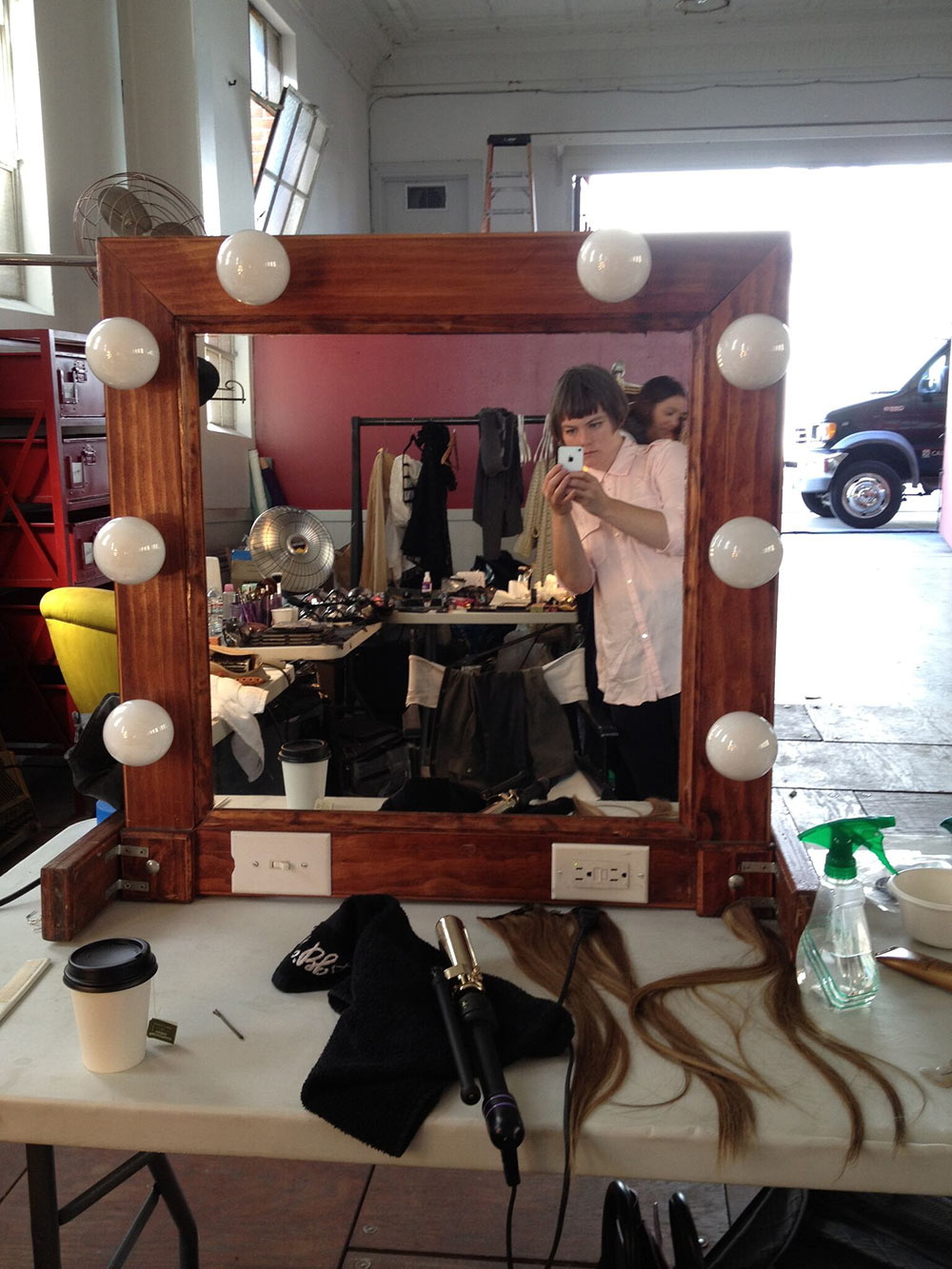Ep. 93: Designer Ana Monroe
Designer / public servant, Ana Monroe, grew up in the south to radio station-owning liberals who taught her to reject the status quo in favor of positive change. While she never did inherit her Panamanian-born mother’s wild, beautiful curls, she did pick up her wide-open ideas about beauty. After graciously rejecting the idea of law school, she embarked on a series of professional adventures that led to her current work as a human-centered design leader at a federal government think tank.
Follow Ana on Instagram @anatecture and @fitzyfitzyfitz and check out Generations Project at generationsproject.us.
What is your earliest memory?
The stairway down to our half-below-ground den in my childhood home. It had this deep, dense, light brown carpet on it, and a big — enormous, in my memory — triangle step at the bottom ending in the cool, smooth tile floor of the big den. I thought it was so grand that our stairway had a big triangle step in it. I liked to lay on my belly on the carpeted triangle while pressing my palms against the tile to feel how the two materials felt different.
Baby Ana and family
How do you feel about democratic design?
If you mean design in democracy / the civic space:
Design’s intentionality brings great opportunity to the public policy space. Lots of our more negative experiences with government specifically and in public functions generally result not of any malicious intent, but from a lack of systems-level thinking and execution by the people who created and / or administer those experiences.
Designers are, by necessity, systems thinkers. Every time I see an elegant, well-functioning design system, I see hope that our democracy can work better for the public. Because whoever can design a good design system or code base or film or whatever, thinks at a systems level. They express value sets through their work, intentionally choosing to emphasize what is important and what is less important in their systems’ cases. Government is almost entirely interconnected systems and expressions of value sets of those systems. Making all these work together; changing the ones that need to evolve, creating new ones when necessary, is all public sector design is; that’s what makes it hard. For this reason, I feel like a lot of designers should consider, at some point in their careers, applying their skills and talents in the public sector; it’s super fascinating. And super hard — did I mention that?
If you mean the democratization of design, aka Is Art for Everyone?
My partner, Scott Kellum, calls this the d.school versus Dribble design communities.
I think that the fractures emergent between Design and design are some of the most terrifying and energizing prospects we face as a discipline right now. Big D Design seems to either mean someone who can photorealistically render a spacecraft in .5 seconds or someone who’s gone to an expensive, conceptual school where you’re graded on, oh idk — the amount of words you can use to talk “around” something.* Both call themselves Designers, but in the former craft is king, while in the latter people champion process above all else.
On the little d design branch, first explored by Stanford’s d.school and then very effectively marketed by others, design seems to be something a bit too shallow and undefined for comfort. The practice of design is quick and agile and sometimes glib; it’s not too well-focused, and, for this reason, anyone from any discipline can access and learn it.
My question is: why are the designers fighting and what do the designers think they’re learning? I think they all have points, and the best path is the hardest one: an evolution to embrace and appreciate these disparate strengths. Because having a great rendering is a powerful, powerful tool; having nuanced thinking and rigorous process will get us to the C suite and ensure the integrity of our work, and having people from other disciplines work with us can only strengthen the depth and impactfulness of our research and solution sets.
In one of my recent projects, the Human-Centered Design Guide series, I go deep on why the craft and process of what big D Designers do is tough, how teams of little d designers can access that thinking and some of the practice, and why those teams might want to invest in learning what a big D Designer can bring to the table in terms of craft and strategy. I hope people use the series, and I hope more Designers find themselves brought in to projects at the strategy stage while also being invited to stay on through outcomes and to practice their craft.
*As a graduate of those exact types of institutions, I feel very comfortable saying that.
D-Coder
Studio
What’s the best advice that you’ve ever gotten?
“I’m sure if you think and type at the same time, you’ll get it done.” — said a true asshole I once dated, but even assholes get it right sometimes.
How do you record your ideas?
My dad, a photographer, loves to remind me that “The best camera you have is the one you have with you!” No matter what you’re doing, if a good photo comes along you use whatever camera you have to capture it, even if it’s just your phone. Following this logic, I record my ideas in whatever I have on hand: I’ve called myself and left voicemails (but please never leave me a vm; I hate them), dm-ed myself, recorded voice notes, filled up the backs of receipts, and torn grocery bags apart to make big sheets of paper. What ever’s around becomes the thing I record on. The only issue I ever really have is finding the time to enact all my ideas.
What’s your current favorite tool or material to work with?
Always and forever: a 1.6mm Bic pen.
What book is on your nightstand?
The Master and Margarita by Mikhail Bulgakov, the Prevear and Volokhonsky translation. First of all, Bulgakov’s masterpiece is a riot of satire, spiritualism, romantic love, and epic tragedy; everyone should read it! And if you have to read it in translation, you should read this edition. Volokhonsky and Prevear work as a team. First, Volokhonsky makes an accurate-though-unbeautiful English translation from the Russian. Then Prevear, a poet by training, works the English into a lyrical form that reflects the feel and intention of the original Russian as closely as possible.
This workflow resonants with me because understanding almost anything requires that we invest in both the literal and the figurative, the practical and the conceptual, parts of that thing. Their work reminds me a lot of what we do when we find ourselves working in well-functioning, well-supported, and well-intentioned design teams.
Why is authenticity in design important?
Because people can sense a fake.
Favorite restaurant in your city?
Rincome. It’s a Thai spot run by two sisters housed in the basement of a Days Inn in Arlington, VA. It’s amazing.
What might we find on your desk right now?
Marie Kondo’s nightmare
Who do you look up to and why?
Because they all combine(d) extraordinary intelligence with extraordinary humanity: RGB, attorney, Tina Turner, musician, Sherry Turkle, designer?, Grace Hopper, mathematician, Raymond Carver, writer, Dolly Parton, musician, Umberto Eco, writer, Arianne Miller, civil servant, Jerome B. Wiesner, scientist, Shaniqwa Jarvis, photographer, Twila Tharp, dancer, my parents, too much to describe, my grandparents, see previous.
What’s your favorite project that you’ve done and why?
I think my favorite for-work project has to be the project I’m directing now, the Human-Centered Design Guide series. In it, we’re setting up guidance on design practice (not just design thinking!) for managers in the government and wider public sector. Digital and traditional design; service, system, and products; from early research to measurement in after launch, we’re covering it. We’ll be halfway through publication when we launch the next editions in September!
In terms of personal projects, Generations Project has my heart right now. It’s such a marriage of all the things I love: product design and problem solving, democracy and art, friendship and action. The platform is really growing as we connect people to the areas of activism they most care about in ways that they can effectively and sustainably engage. If you’re curious, especially as the 2020 election cycle approaches, please check out our newsletter; you can sign up at https://generationsproject.us. Ask us questions, too! Everyone is welcome.
What are the last five songs you listened to?
Roland the Headless Thompson Gunner - Warren Zevon
The song revolves around this Scandanavian mercenary, Roland, who’s fighting in the US - USSR proxy war in Congo in the 1960s. The war, like all wars, was really nasty, but this one was made even worse by the deeply cruel and racist traditions of the former colonial power, Belgium. We don’t hear about this war much in our history classes in the U.S., which is unforgivable, but you can listen to this song and get a feel for the moment. It’s surprisingly catchy for how chilling the subject is.
‘Cause I Love You - Lizzo
I just went to a Lizzo show, and, if you haven’t screamed the lyrics to this song alongside 300 other sweaty, dancing people, I highly recommend it.
Lissie’s cover of Kid Cudi’s Pursuit of Happiness
That phrase, “pursuit of happiness”, in the Declaration of Independence always fascinates me. Thomas Jefferson really threw us a curve ball when he wrote it, because what does it even mean?! Something different for everyone, which is what makes living together as a society so complex. Kid Cudi’s super poppy, really fun version is all about partying and not thinking about tomorrow, while Lissie’s less polished cover seems to make a commentary on continuing to pursue what drives you, even if it’s not something most people think you’ll succeed at, like being a musician. Or a designer, for that matter.
It’s So Easy - Louis Cole
I know nothing about the background of this song or singer, but Louis Cole’s Album 2 is somehow beautifully arranged, dancey, and dark without tipping over into self-referential millennial irony.
Too Much - Carly Rae Jepsen
While of course I realize CRJ is mostly the candy coating on the outside of the music world, IMHO this song centers on, surfaces, and then celebrates by inverting one of the central conflicting messages women absorb everyday: that we’ll never quite get it right.
Because no matter what we do, we’re either doing too little, not being a “girl boss”, or we’re too much: somehow self destructive and / or a diva. When Carly says “When I party then I party too much...when I’m thinking then I’m thinking too much…” I think of all the times exes and bosses who shamed me for being complex and interested in lots of things. They wanted me to shut up and know my place. Then when they needed that complex thinking or varied interest to solve one of their problems, they would come around and tell me I needed to be more engaged, more deeply invested, more attentive, etc, to my relationship or my career or whatever part of my life they revolved in.
It’s ridiculous how much women are expected to do, how many people stack up expectations for us to fulfill, and how they think they have the right to tell us when we’re not doing it they way they think we should. So CRJ wrote a song about it, and I unashamedly dance to it at bus stops, in my office, in my airline seat, etc etc. Because the thing is, I’ve always been too much.
Clever is produced by 2VDE Media. Thanks to Rich Stroffolino for editing this episode.
Music in this episode courtesy of El Ten Eleven—hear more on Bandcamp.
Shoutout to Jenny Rask for designing the Clever logo.













